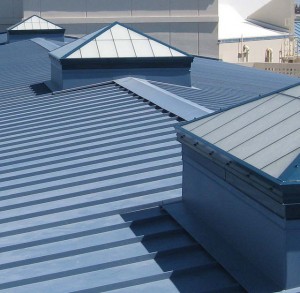 Commercial roofing is an important aspect of any building. The foundation, the walls, and the roof conspire to make a building secure enough to do business within. If any one part of this commercial roofing system should falter, it would weaken the integrity of the entire building. The roof is designed to provide protection for the rest of the complex. Without it, the walls, ceilings, and floors would be subject to the elements and it would be challenging to get any customers through your doors. Although both are meant to protect the structure below, residential and commercial roofs differ in many ways. Here are the most common types of commercial roofing materials:
Commercial roofing is an important aspect of any building. The foundation, the walls, and the roof conspire to make a building secure enough to do business within. If any one part of this commercial roofing system should falter, it would weaken the integrity of the entire building. The roof is designed to provide protection for the rest of the complex. Without it, the walls, ceilings, and floors would be subject to the elements and it would be challenging to get any customers through your doors. Although both are meant to protect the structure below, residential and commercial roofs differ in many ways. Here are the most common types of commercial roofing materials:
Commercial Roofing Material Types
Slate
One of the most expensive forms of commercial roofing materials is slate. Of course, it is also one of the longest lasting. If you put it in terms of lifespan, slate could easily last long enough to more than make it the most economical return on investment. It is durable, available in a large selection of sizes, and it typically costs very little to maintain. At a time when green contracting is all the rage, many environmentalists look favorably on slate due to its ability to be recycled or tossed into a clean landfill.
Asphalt
There are few applications as economical up front as asphalt. This will typically be the first choice of small business owners looking to get off the ground for the lowest possible start up costs. Of course, for every advantage, there is an equal and opposite disadvantage. In asphalt’s case, it means you’re dealing with a material that may deteriorate more quickly than other applications. This is especially true in areas where the climate is unpredictable and harsh.
Metal
Metal is one of the strongest commercial roofing materials. By that, it means you won’t have to deal with a leaky roof in the near future if everything goes well. Of course, if you deal with a lot of storms, it should be noted that many lightweight metal roofs may not fare as well as heavier materials. And if you want to hold a conversation inside when it’s raining, you can probably forget about it with a metal roof.
Rubber
A rubber roof is currently the most common material used for commercial roofing. This is because it is very effective at keeping water from penetrating into the roof, is economical and is easy to install. Installing a rubber roof is very similar to painting. A long roller is used to roll layers of paint-like material over the entire surface of the roof. As the substance hardens, it begins to solidify, looking and feeling like the rubber material we are all familiar with. However, while there are advantages to a rubber roof, there are also disadvantages. The biggest disadvantage is that rubber expands and contracts when it is hot or cold out. Overtime, this can cause the rubber to develop cracks in it. Therefore, rubber roofs need to be inspected and repaired often.
This is, of course, just a sample of the many commercial roofing materials available for use. If you are looking into building offices, schools, or other enterprises, you should contact a reputable roofing contractor and discuss your options. Once you’ve described exactly what you’re looking for in a roof, you’ll be able to come to a decision that suits your needs perfectly.